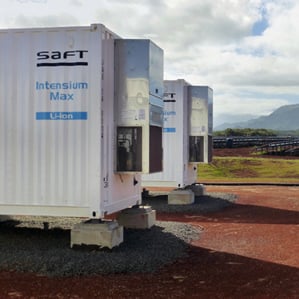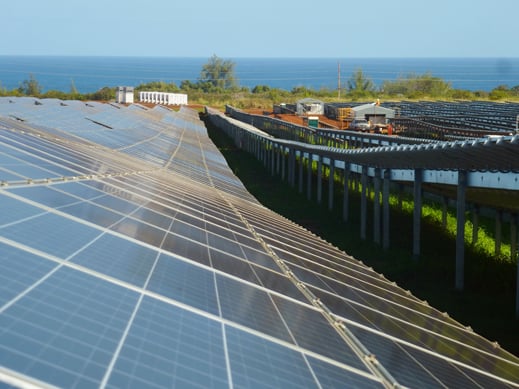Hawaii’s Solar Push Strains the Grid
The prospect of cheaper, petroleum-free power has lured the Kauai Island Utility Cooperative (KIUC) to quintuple utility-scale solar capacity over the past year, building two 12-megawatt photovoltaic arrays. These facilities are the biggest and a significant contributor to the island’s 78-megawatt peak power supply. When the second plant comes online this summer, peak solar output on Kauai will approach 80 percent of power generation on some days, according to Brad Rockwell, the utility’s power supply manager.

That puts Kauai on the leading edge of solar power penetration, and KIUC has bruises to show for it. Power fluctuations from a first large plant installed in 2012 have already largely burned out the big batteries installed to keep solar from destabilizing the island’s grid.
Now KIUC is taking a second try with batteries and hoping energy storage technology has progressed sufficiently to keep the same problems from recurring. The new system, installed beside the solar farm nearing completion on Kauai’s northeast shore, is one of the first commercial installations of grid-scale lithium-ion batteries manufactured by the French battery giant SAFT.
The intermittent nature of renewable energy sources like solar power presents a range of challenges to utilities, depending on their grid’s size and design. Kauai’s difficulty is most acute when clouds drift over a solar plant. That can slash a plant’s power output by 70 to 80 percent in less than a minute. If the plant is providing a substantial share of the grid’s power, that rapid power loss can cause the frequency of the grid’s alternating current to drop well below 60 hertz, damaging customer equipment or even causing a blackout.
Kauai’s first energy storage system, at the six-megawatt photovoltaic plant at Port Allen on Kauai’s west side, was designed to mitigate such “frequency droops” by releasing stored power when output crashed. But when the plant went live in December 2012, Rockwell and his engineers quickly discovered that, as Rockwell puts it, the battery is “just not what it was cracked up to be.”

The $2 million system, designed and manufactured by Xtreme Power of Lyle, Texas, has plenty of muscle, releasing up to 4.5 megawatts in quick bursts. What it lacks is stamina. Frequency droops occurred more often than KIUC had expected, and on partly cloudy days the battery quickly ran out of energy.
Running down the charge day after day, meanwhile, degraded the batteries’ energy capacity. While Xtreme Power called them “advanced” lead-acid batteries because they initially packed more energy and power than their predecessors, they suffer from the same sensitivity to repeated cycling long associated with lead-acid batteries. The Xtreme Power system was designed to last eight years, but two years in it has “very little” capacity left, according to KIUC.
As a result, KIUC has had to ask more of its diesel and gasoline-fired generators, improving their ability to ramp up during frequency droops. The heavy ramping puts wear on the machines, increases air pollution, and negates some of the petroleum savings promised by the solar plants. “I think we have lost a couple of percentage points on efficiency over the last year,” Rockwell says. “The maintenance impacts are yet to be seen.”
A bigger battery and better software controls might have delivered better results from Xtreme Power’s lead-acid batteries, says John Jung, CEO of Greensmith, a storage systems provider based in Emeryville, California. But the problems KIUC encountered were shared by other Xtreme Power clients, and Xtreme Power declared bankruptcy in January 2014. The Berlin-based energy storage firm Younicos bought the company three months later, minus the battery manufacturing assets.
Lithium-ion batteries, which KIUC is pinning hopes on now, endure cycling better than lead-acid batteries. John Cox, KIUC’s engineering manager, says SAFT’s lithium-ion batteries are rated for four to six times as many full charge-discharge cycles as Xtreme Power’s.
Patches of clouds drifted over Anahola earlier this month when I visited the site of KIUC’s next solar plant, where eight 22-foot-long shipping containers full of SAFT’s batteries were already in place beside the plant’s 57,000-plus photovoltaic panels.
SAFT’s $7 million system can deliver six megawatts of power continuously and up to 12 megawatts in short bursts—equal to the Anahola array’s peak output. And SAFT claims it can absorb up to 4.5 megawatts continuously.
Recharging should be fast enough to keep the battery operating throughout every day with power fluctuations of no more than 1.2 megawatts per minute, according to Jim McDowall, business development manager for SAFT’s Connecticut-based subsidiary SAFT America.
McDowall is especially confident about the Anahola installation, which has extra energy storage capacity at KIUC’s insistence. This extra capacity is unlikely to go to waste, he and Rockwell say. It will enable the Anahola battery to arrest some of the frequency drooping caused by Kauai’s other solar farms, easing the strain on KIUC’s conventional generators. Extra storage capacity at Anahola could also help Rockwell manage a new problem that he expects to confront before the end of this year: excess solar power generation.
After Anahola comes online, Rockwell expects Kauai to see days when clear skies result in solar generation beyond what KIUC’s grid can carry. Instead of throwing away the excess, McDowall says, KIUC could use the Anahola battery storage system to absorb it and then release that power after the sun goes down.
Keep Reading
Most Popular
Large language models can do jaw-dropping things. But nobody knows exactly why.
And that's a problem. Figuring it out is one of the biggest scientific puzzles of our time and a crucial step towards controlling more powerful future models.
The problem with plug-in hybrids? Their drivers.
Plug-in hybrids are often sold as a transition to EVs, but new data from Europe shows we’re still underestimating the emissions they produce.
Google DeepMind’s new generative model makes Super Mario–like games from scratch
Genie learns how to control games by watching hours and hours of video. It could help train next-gen robots too.
How scientists traced a mysterious covid case back to six toilets
When wastewater surveillance turns into a hunt for a single infected individual, the ethics get tricky.
Stay connected
Get the latest updates from
MIT Technology Review
Discover special offers, top stories, upcoming events, and more.